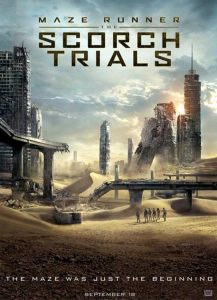(Rated PG [Canada] and PG-13 [MPAA] for extended sequences of violence and action, some thematic elements, substance abuse and language; directed by Wes Ball; stars Dylan O’Brien, Kaya Scodelario, Thomas Brodie-Sangster, Ki Hong Lee, Jacob Lofland, Rosa Salazar, Lili Taylor, Patricia Clarkson, Giancarlo Esposito, Barry Petter and Aidan Gillen; run time: 132 minutes.)

A-mazing strikeout
By Ted Giese
“Star Wars V: The Empire Strikes Back” is widely considered one of the best movie sequels of all time. “Maze Runner: The Scorch Trials” is no “Empire Strikes Back.”
“Maze Runner: The Scorch Trials” is Wes Ball’s follow-up to his film “The Maze Runner” (2014), based on the young-adult sci-fi book by James Dashner. Picking up where the previous film left off, Thomas (Dylan O’Brien), Teresa (Kaya Scodelario) and their surviving friends — the Gladers — who escaped the maze of the first film, find themselves catapulted into a bigger story with new challenges. The story takes place in an environment as harsh as the maze, just as unforgiving and just as deadly, so again the theme is about overcoming adversity while trying to escape.
The first film was about escaping the maze made by the biotech-obsessed paramilitary organization called WCKD (WICKED — World in Catastrophe: Killzone Experiment Department). This second film is about escaping from WCKD’s plans to use the teens for continued laboratory experiments to find a cure for a disease called “the flare.”
In their efforts to escape, Thomas and his friends must cross a scorched, post-apocalyptic wasteland avoiding the human victims of “the flare” who tragically have turned into something like fast-moving zombies called “Cranks.” They also must deal carefully with the other survivors, who live in the Scorch as they work their way to a group of resistance fighters (The Right Arm) in the mountains. The survivors hope these resistance fighters can get them safely to a place called “Safe Haven.”
The James Dashner book series from which these films are drawn is a derivative imitation of dystopian young-adult works like Suzanne Collins’ “The Hunger Games” and Orson Scott Card’s “Ender’s Game.” These books, and books like Veronica Roth’s “Divergent” series, have all received the big-budget Hollywood film treatment lately. And with all these teen, dystopian, angst-ridden films hitting the theaters, directors like Wes Ball have their work cut out for them: How do you make your movie series stand out from the crowd?
Like all these other films, “Maze Runner: The Scorch Trials” has lots of action, its share of paranoia and brooding, good-looking teen characters with a dash of romance. Nothing new here. Sadly, some of the distinctive things that made the first “Maze Runner” film intriguing and fun are missing. Gone is most of the Gladers’ inventive slang. In fact, it’s hard to remember if the Gladers (again, the group of teens who survived the maze of the first film) are even called Gladers in this second film. The first film had a lot of running; this second film also has a lot of running. What the film doesn’t provide is answers. While the first film set up a mystery and planted the hope that a second film would provide some answers, what we have instead are more questions. This could easily leave viewers unfamiliar with the book series confused and frustrated.
As in the first film, Thomas’ scepticism drives his actions and those of his fellow Gladers as they run from scene to scene. And while the Gladers are not always entirely sure about the direction Thomas is taking them, they are portrayed as very trusting (the question isn’t whether Thomas is trustworthy but whether he’s making the best choices). Could Thomas simply be naive? Could the mantra “WCKD is good” be true? After all, WCKD is trying to cure the disease threatening humanity. Does Thomas actually have a plan?
There is a tendency to want to root for a film’s lead character even when he is less than heroic. In “Maze Runner: The Scorch Trials,” some of Thomas’ heroic luster is becoming dull; he comes across as less brave and more stubborn. Is Thomas an admirable role-model character, someone to be looked up to? This is a legitimate question Christian viewers may want to ask.
Because the central character’s name is Thomas, Christian and non-Christian viewers alike are in a way invited to make a connection to St. Thomas from the Gospels. In the first film, it was easier to make the comparison; in this film, Thomas emerges as a character in contrast with St. Thomas. He still has elements of bravery and is still someone with questions about his situation, but this Thomas is less virtuous. Where will this character land by the time the credits roll on the final installment, “The Maze Runner: The Death Cure,” set for release in 2017? Based on this film, Thomas’ future is as murky as his past.
(Editor’s note: For more background on the analogy between these two Thomases, see Giese’s 2014 review of “The Maze Runner.”)
The film is rated PG-13 and isn’t appropriate for children. Also, its 132-minute running time feels long. No amount of running, explosions or “zombies” can fix that. Can it hold the audience’s attention? Will they care to know what happens next? A movie like “Star Wars V: The Empire Strikes Back” left audiences hungry for more. After watching this film, will people be hungry for more? “Maze Runner: The Scorch Trials” is truly dystopian, and darker and harder-edged than the first film in the franchise. What it lacks most is originality, inventiveness and fun.
The Rev. Ted Giese is associate pastor of Mount Olive Lutheran Church, Regina, Saskatchewan, Canada; a contributor to “Reformation Rush Hour” on KFUO-AM Radio, The Canadian Lutheran and Reporter/Reporter Online; and movie reviewer for the “Issues, Etc.” radio program. Follow Pastor Giese on Twitter @RevTedGiese.
Posted Sept. 29, 2015




